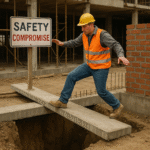|
Getting your Trinity Audio player ready...
|
As someone who has spent nearly three decades doing the hard yakka on Australian construction sites, including plenty of FIFO stints, the landscape has been observed to change dramatically. The industry is renowned for its grit, the enduring mateship among workers, and the incredible feats of engineering that shape our nation. Yet, beneath the surface of these achievements, a silent struggle persists, a crisis of mental health that has been bubbling away for far too long. It is now imperative to bring this critical issue into the light.
This discussion extends beyond traditional physical safety concerns; it encompasses the wellbeing of every individual on a construction site—the chippy, the sparky, the labourer—who may be doing it tough, battling challenges that are not immediately visible. The demanding physical labour, long hours, and high-pressure environments inherent in this sector are taking a serious toll on its workforce 1.
The statistics are stark. The industry is losing too many skilled individuals to suicide, tragically more than to workplace accidents.1, This situation is not merely a personal tragedy for families; it represents a significant economic burden, estimated to cost the Australian economy $1.57 billion annually. 5 This is a crisis that demands comprehensive attention, moving beyond superficial remedies to address its deep-seated roots.
The very nature of this crisis, often hidden due to a prevailing culture of silence, acts as a significant barrier. When struggles remain concealed, individuals endure prolonged suffering, and the collective issue remains unaddressed, perpetuating a cycle where stoicism contributes directly to the severity and persistence of the problem.
This report will delve into the latest statistics, uncover the underlying causes of mental ill-health, and highlight the unique challenges faced by construction workers, particularly those engaged in Fly-In Fly-Out (FIFO) arrangements. It will examine the initiatives currently striving to address this tide, assess their effectiveness, and analyze the impact of government spending.
Crucially, this article aims to outline a clear path forward—a blueprint for policy changes, cultural shifts, and enhanced peer support systems—to ensure every worker receives a fair go at a mentally healthy life.
Importantly, the substantial economic cost associated with poor mental health in the industry provides a compelling commercial imperative for immediate and sustained action, transforming mental health from solely a welfare concern into a strategic economic investment 13
The Hard Yakka of the Mind: Understanding the Crisis
The national figures on suicide in Australia provide a sobering context for understanding the crisis within the construction industry. The consistently high proportion of male suicides nationally, at around 75%, holds particular significance for the construction industry, given that its workforce is approximately 87% male 1.
This demographic reality means that national male suicide trends serve as a strong proxy for understanding the general trajectory of risk within the construction sector. Furthermore, the relatively young median age of suicide (45.5 years) highlights a profound loss of potential life years, indicating that these tragic deaths are occurring at a critical productive stage of workers’ lives, impacting not only individuals and families but also the broader economy 3,
The following table provides a clear, concise comparison that immediately highlights the disproportionate burden of mental health issues and suicide within the construction industry compared to the general population. It grounds the narrative in hard data, making the crisis tangible and undeniable for government decision-makers. The inclusion of the “suicide vs. accident” comparison is particularly impactful, as it reframes safety beyond just physical hazards.
Table 1: Australian National Suicide Statistics (2019-2023) – Overview
| Year | Total Deaths by Suicide (Australia) 3, 2, 19, 18 | Age-standardized Rate (per 100,000) 3, 2, 19, 18 | Male Deaths by Suicide 3, 2, 18 | Female Deaths by Suicide 3, 2, 18 | Male Age-Standardized Rate (per 100,000) 3, 2, 18 | Female Age-Standardized Rate (per 100,000) 3, 2, 18 |
| 2019 | 3,318 | 13.2 | 2,626 | 692 | 20.1 | 6.4 |
| 2020 | >3,000 | – | >2,250 (est. 75%) | <750 (est. 25%) | – | – |
| 2021 | 3,166 | 12.1 | 2,398 | 799 | 18.5 | 6.1 |
| 2022 | 3,249 | 12.3 | 2,455 | 808 | 18.9 | 5.9 |
| 2023 | 3,214 | 11.8 | 2,419 | 795 | 18.0 | 5.8 |
Note: Data for 2020 is an approximation based on general statements. 2021 data have been subject to revision; 2022 data are preliminary revised; and 2023 data are preliminary. Care should be taken when comparing 2023 data to previous years due to open cases in NSW.
Within the construction sector, the situation is even more alarming. Workers in this industry are six to eight times more likely to die by suicide than from a workplace accident. This striking comparison reveals a critical disparity: an industry built on stringent physical safety protocols is losing more lives to an unseen adversary than to tangible hazards.
To put this into further perspective, Australia loses one construction worker to suicide every two days, equating to over 190 cases annually. Overall, construction workers are 53% more likely to take their own lives than other employed men in Australia 1.
A particularly vulnerable demographic within this crisis is young workers, who are twice as likely to die by suicide compared to other young Australian men.8 Recent research in Western Australia further revealed that suicidal thoughts and behaviours among construction workers are approximately three times higher than those typically observed in the general adult Australian population, with symptoms of depression and anxiety occurring at twice the national average. 9
These figures transcend mere statistics; they represent individuals, colleagues, and family members. The disproportionate rates strongly indicate that fundamental aspects of the industry itself are significant contributors to this crisis.
Beyond the tragic outcomes of suicide, the prevalence of mental ill-health is widespread. More than 20% of workers in the construction industry have reported experiencing a mental health condition.1
A comprehensive survey indicated that one in four construction and utilities workers exhibited high symptoms of depression and/or anxiety. Burnout is also rampant, with nearly half of infrastructure construction workers meeting the criteria for it, and 85% reporting moderate to high stress levels. What this paints is a picture of an industry under immense psychological strain, where stress, anxiety, and depression are not isolated incidents but pervasive issues impacting a significant portion of the workforce.
For those engaged in Fly-In Fly-Out (FIFO) work, the mental health challenges are compounded. Large Australian studies demonstrate significantly higher rates of depression and anxiety among FIFO workers compared to the general population. A report from the WA Mental Health Commission found that 33% of surveyed FIFO workers reported high or very high levels of psychological distress, contrasting with 17% in a benchmark group.24,
The unique work-life balance challenges, prolonged isolation from family and friends, limited control over on-site living conditions (such as meals and accommodation), and demanding “four-and-one rosters” are major contributors to family breakdown, community dysfunction, and elevated suicide risk.5. The risk of anxiety and stress is also twice as high for younger FIFO workers.23 The FIFO model, while economically driven, carries profound mental health implications, often leading to substance abuse as a coping mechanism
Table 2: Australian Male Construction Worker Suicide Rates vs. Other Male Workers (2001-2019)
| Year Block | Industry Group | Age-Standardized Suicide Rate (per 100,000 workers) 5, 7, 15, 26, 11, 27 |
| 2001–2006 | Construction | 29.9 |
| All other workers | 14.1 | |
| 2007–2011 | Construction | 29.1 |
| All other workers | 13.0 | |
| 2012–2019 | Construction | 24.0 |
| All other workers | 10.8 | |
| Pooled (2001-2019) | Construction | 26.6 |
| All other workers | 13.2 |
Source: Adapted from Maheen et al. (2022). 5, 7, 15, 26, 27
Note: This data provides the most granular industry-specific suicide rates available in many scattered sources, extending only to 2019. Precise, up-to-date construction-specific suicide data for the most recent five-year period (2019-2024) is not readily available in public reports.
Beyond the Bricks and Mortar: Root Causes and Psychosocial Hazards
The mental health crisis in Australian construction is not a singular issue but a complex interplay of environmental, cultural, and individual factors. Understanding these underlying psychosocial hazards is crucial for developing effective interventions.
The industry is overwhelmingly male-dominated, with approximately 87% of workers identifying as male.1, 15. This demographic reality often fosters a “macho” culture where emotions are suppressed, and vulnerability is perceived as a weakness. This unwritten code of stoicism means that workers frequently suffer in silence, reluctant to seek help due to fears of job loss, being perceived as weak, or a lack of competence. This cultural factor is a significant barrier, with 70% of workers reporting discomfort discussing mental health issues with colleagues or supervisors. This is not merely a symptom of poor mental health but a fundamental cause, actively preventing individuals from seeking the support they desperately need when their stoicism inevitably falters.
The project-based nature of construction work frequently leads to unreasonable and tight deadlines, resulting in extreme stress and intense pressure to avoid costly delays. Long, inflexible working hours are commonplace, with over 60% of employees reporting working more than 50 hours per week. This chronic stress contributes significantly to burnout, anxiety, and depression. These are systemic issues embedded within the industry’s operational model, directly impacting the mental well-being of its workforce.
Job insecurity is another pervasive stressor. Many workers are employed on a project-by-project basis, leading to significant periods of uncertainty about future work. This financial precarity, particularly for sole earners, amplifies the mental toll. The transient nature of employment adds another layer of stress beyond the immediate job demands, contributing to a constant underlying anxiety about future stability.
For those in FIFO roles, home-work conflict is a top-ranked factor for poor mental health outcomes, often exacerbated by uncertain work schedules and extended periods away from home. This is particularly acute for remote workforces and FIFO groups. The separation anxiety experienced by children of FIFO parents is akin to that observed in military families. The FIFO model, while economically driven, carries profound mental health implications, often leading to substance abuse as a coping mechanism.
Workplace bullying and harassment are identified as key contributors to mental health issues. Apprentices are particularly vulnerable, with 27.3% reporting experiences of bullying and 30% reporting suicidal thoughts. Hostile work environments demonstrably increase stress and anxiety. Furthermore, racism and discrimination, often perpetrated by co-workers, contribute to mental health risks for migrant workers. These are not merely interpersonal conflicts but psychosocial hazards that employers bear a legal responsibility to manage effectively.
Alarmingly, rates of alcoholism and substance abuse within the Australian construction industry are higher than the national average, especially among younger and middle-aged workers. Many FIFO workers, in particular, resort to alcohol and/or drugs as a coping mechanism for depression and anxiety, creating a vicious cycle that further exacerbates mental health issues and increases safety risks on site.
These factors do not exist in isolation; they are interconnected, forming a complex web of causal relationships that create a reinforcing cycle of distress. For instance, the relentless pressure of long hours can lead to home-work conflict, which might then contribute to increased substance abuse as a maladaptive coping mechanism, further exacerbating mental health issues. Addressing one without considering its links to others may yield limited results, thus requiring holistic and integrated solutions. The problem is not solely about individual coping abilities; it is deeply embedded in the fundamental environment and operational models of the industry. Focusing solely on individual resilience training, therefore, is insufficient and risks overlooking the powerful, systemic drivers of mental ill-health.
The following table systematically categorises the complex interplay of factors contributing to the mental health crisis. It provides a clear, actionable overview for government and industry to identify specific areas for intervention, moving beyond a superficial understanding of “stress” to pinpoint the root causes.
Table 3: Key Psychosocial Hazards in Australian Construction
| Psychosocial Hazard | Description & Impact | Relevant Snippets |
| “Macho” Culture & Stigma | Pressure to suppress emotions, fear of appearing weak, reluctance to seek help, and suffering in silence. | 1, 4, 13, 21, 16, 28, 17 |
| Long Hours, Tight Deadlines, Workload Pressure | Chronic stress, burnout, anxiety, depression due to project-based work, unreasonable deadlines, and excessive hours (60%+ work >50 hrs/week). | 1, 3, 4, 5, 13, 8, 16, 29, 9, 10, 33 |
| Job Insecurity & Transient Work | Financial precarity and uncertainty about future employment due to project-by-project contracts. | 1, 13, 16, 29, 26 |
| Home-Work Conflict & Social Isolation (especially FIFO) | Elevated psychological stress from balancing work demands with personal life, exacerbated by remote work and FIFO rosters, leading to family separation. | 5, 13, 14, 23, 24, 25, 9 |
| Bullying, Harassment & Toxic Work Environments | Increased stress, anxiety, and suicidal thoughts, particularly for apprentices, due to hostile interactions, racism, and discrimination. | 1, 3, 4, 6, 13, 7, 14, 16, 30, 31 |
| Alcohol & Substance Abuse | Higher rates than the national average, often used as a maladaptive coping mechanism for depression and anxiety, creating a vicious cycle and increasing safety risks. | 1, 7, 14, 24, 25, 16 |
| Low Job Control & Role Ambiguity | Feelings of unmotivation and depletion when workers lack control over how they work or decisions affecting them, or when roles are unclear. | 4, 13, 21, 33, 22 |
| Financial Concerns | Significant impact on mental health, often linked to job insecurity and the pressure of being a sole earner. | 1, 3, 13, 29 |
| Physical Demands & Chronic Pain | Physically demanding labour leading to pain, with pressure to work through it, is linked to depression and reluctance to discuss mental health. | 34 |
| Workplace Injustice | Perceived unfairness or lack of equity in the workplace, contributing to mental health risks. | 13 |
Building Bridges: Current Initiatives and Their Impact
Amidst the challenges, vital industry-led initiatives are making a tangible difference. MATES in Construction is one of the prominent example, a charity established in 2008 with the explicit aim of reducing the high rates of suicide among Australian construction workers. Their foundational philosophy is that “suicide is everyone’s business”. They operate on a community development model, delivering multimodal programs directly on construction sites.
Key components of the MATES program include:
- General Awareness Training (GAT): Provided to all workers on a worksite, this training aims to raise awareness about suicide and mental health.
- Connectors: These are volunteer workers specifically trained to link workmates in distress to appropriate support services. They serve as a crucial first point of contact, leveraging existing relationships and the inherent mateship within the industry to facilitate help-seeking.
- Applied Suicide Intervention Skills Training (ASIST): This provides more intensive training for key personnel, enabling them to offer direct support to colleagues in crisis.
- Apprentice and Supervisor Training: These targeted programs are designed to foster a pervasive culture of care and concern across all levels of the workforce.
- 24/7 Helpline and Case Management: MATES offers direct intervention services and continuous support for workers in need through a dedicated helpline and case management services.
Similarly, Incolink’s “Bluehats” program is another vital peer-to-peer initiative. Designed by the industry, for the industry, it actively challenges the stigma surrounding suicide and trains workers to recognise signs of stress in themselves and others. The program also offers a 24/7 counselling helpline and on-site health checks. These programs are particularly effective because they directly address the cultural barriers prevalent in the industry by empowering workers themselves to become active participants in the solution, rather than solely relying on external mental health professionals.
The evidence supporting the effectiveness of these programs is robust. MATES programs have been shown to effectively transform the knowledge, attitudes, and behaviours of construction workers. A systematic review encompassing 12 peer-reviewed articles found compelling evidence of MATES’ effectiveness in improving mental health and suicide prevention literacy, enhancing helping intentions, and significantly reducing stigma. Favourable results have been observed in relation to reduced suicide risk within the construction industry
One study conservatively estimates that the MATES program saves at least one worker’s life each year, generating an impressive $14.2 million in societal savings. The potential return on investment (ROI) is a remarkable 1:4.42 or 1:4.60, indicating that for every dollar invested in MATES, a return of $4.42 or $4.60 is achieved. While a direct causal link cannot be definitively established, the observed decline in suicide rates among male construction workers between 2001-2019 may be partly attributed to “sector-specific mental health suicide prevention initiatives” like MATES.
This demonstrates that industry-led, peer-focused programs are not merely feel-good initiatives; they are highly effective and economically justifiable interventions that warrant continued support and potential expansion.
Despite the impressive reach and reported effectiveness of programs like MATES, a significant gap exists between program delivery and actual awareness and utilisation of specific support services. While MATES boasts over 237,000 workers trained and a network of over 21,000 connectors, a survey conducted by MATES itself found that only 50% of workers were aware of their 24/7 helpline.
Similarly, the Black Dog Institute found that 25% of construction workers had never accessed mental health resources. This indicates that while initial training may improve literacy and reduce stigma, the pathway to actual help-seeking remains obstructed for many. Effective communication strategies are needed to ensure workers are not only aware of all available support channels but also feel comfortable and empowered to use them.
The following table provides concrete, quantifiable evidence of the success and economic value of a leading industry-specific mental health program. For the government, it showcases a proven model that warrants continued support and potential expansion. The ROI figure is particularly compelling, demonstrating that investment in mental health is not just a cost but a significant return on investment, aligning with economic imperatives.
READ ALSO: Mental Health: Effective Ways of Dealing with it as a Tradie [2024]
Table 4: Impact of MATES in Construction Program – Key Outcomes and ROI
| Outcome/Metric | Details | Relevant Snippets |
| Workers Trained (GAT) | Over 237,359 workers trained in General Awareness Training | 46, 30, 42, 41 |
| Volunteer ‘Connectors’ | Over 21,888 workers trained as volunteer ‘Connectors’ | 46, 30, 41 |
| ‘ASIST Workers’ | Over 2,889 workers trained in Applied Suicide Intervention Skills Training | 46, 41 |
| Estimated Lives Saved Annually | Conservatively estimated to save at least 1 worker’s life each year | 46, 39 |
| Estimated Societal Savings Annually | Generates $14.2 million in savings to society each year | 46, 39 |
| Return on Investment (ROI) | Equivalent to 1:4.42 or 1:4.60 (for every $1 invested, $4.42 or $4.60 is achieved) |
Although considerable progress has been achieved, it remains inadequate to address the pressing needs of this pandemic. In this second installment of our two-part article, we analyze the discrepancy in government intervention and expenditure, and offer urgent recommendations to alter the current trajectory of this national tragedy.
Click the link to read the second part: Mental Health: The Silent Crisis on Australian Construction Sites







